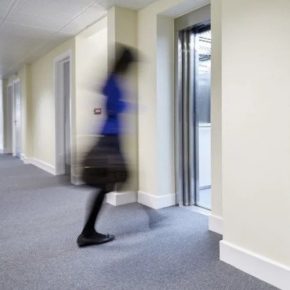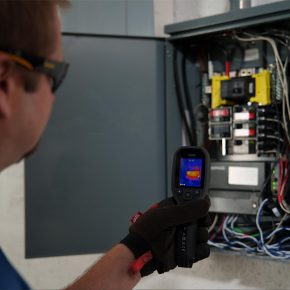Does every educational building in the UK have lifts? Where there is a requirement to travel between floors or over steps, there should be a lift for those less able to do so. Stannah covers some of the considerations for lifts in educational buildings…
Do schools have to have a lift?
When it comes to education, giving all students the same amount of access is important. Providing access for everyone is important for schools, colleges and universities not only because they want to welcome everyone – but also because it’s a legal requirement if there are multiple floors.
What is the disability and access policy in schools?
Under the Equality Act (formally the disability discrimination act) and the Disabilities Education Act UK, owners, controllers or managers of schools and colleges must provide adequate access for those using and visiting their premises with physical or mental impairments.
How to make a school disabled friendly
Choosing the right lift for an educational establishment to ensure facilities for the disabled in schools and enable access for students is an important decision. Examples of reasonable adjustment in schools are a step lift (low-rise platform lift) to assist simple change in a level where a ramp is impractical or a lift if the building has two or more floors that people need to travel between. Lifts that move people fall into passenger lifts or platform lifts. Lifts that move goods are service lifts or goods lifts.
Passenger lifts
A passenger lift is what first springs to mind when you mention the word ‘lift’. These lifts can range in size from 3 to 33 people and beyond, though eight-person is the most common size due to Part M building regulations.
Passenger lifts fall under the Lifts Regulations 2016, so they travel faster than 0.15m/s, allowing for relatively rapid movement of people through a building – typically, a journey takes around 18 seconds between floors.
The installation of a passenger lift requires a lift shaft to house a passenger car, motor and gearbox mechanism and are best suited to:
– New buildings, where it is easier to build a lift shaft or where there is an existing shaft to fit a conventional lift.
– Any building where the lift will get extensive use – either due to the building size or because the lift will be the primary means for travelling between floors.
– Any building that has a large capacity or people traffic, such as large college lifts.

Platform lifts
Platform lifts also transport people, finding particular favour as an access solution for wheelchair users. They are best suited to smaller passenger numbers (up to five people) travelling shorter distances. There are many variants within the platform lift family, ranging in size from one person/wheelchair user to up to five people.
Due to slower speeds, they provide vertical movement between floors in a low-rise building – typically between two to four floors. Platform lift speed is limited to 0.15m/s and falls under the Supply of Machinery (Safety) Regulations 2008, so travel between floors averages around 22 seconds.
Platform lifts have a small footprint, making them very versatile, especially concerning space. They can be used indoors or out and vertically or inclined on staircases. They also allow for certain cost economies compared to a passenger lift, as there is less building work.
Ideal for lifts in schools, existing buildings or small extensions, platform lifts are not suitable for higher travel or frequent use. Here conventional passenger lifts play their role.
Service & Goods lifts
Behind the scenes, service and goods lifts help ensure everything gets to where it needs to be safely and securely – whether it’s library books, food for the canteen, or heavy science equipment.
How do you make a school wheelchair friendly?
As part of inclusive design, lift location is an important decision, and in most cases, building work is involved. When choosing the space for a lift, think about how a person in a wheelchair will access it. In primary (and sometimes secondary) schools, it is good practice to locate the lift where it’s less likely to be tampered with by students.
Safety & additional features
Safety is paramount in the design, construction and installation of any lift, especially when installed in a school, academy or university. Younger children may not understand the need to respect the equipment so certain additional features can be added, including:
– School parking/locking facility
– Intelligent automatic doors or fire doors
– Emergency auto-dialler or intercom
– Uninterrupted power supply (UPS), backup (in case of a power cut)
– Electrical emergency lowering measurements
– Handrail and braille pushes
Also, consider based upon the age and capabilities of the children who use wheelchairs, whether they are permitted to operate the lift or are assisted by support workers.
Swift Installation
Educational buildings have a hive of activity happening daily. To minimise any potential disruption, most lift companies will work out of term time to minimise disruption. Also, it goes without saying that a check that an engineer that works on educational sites is fully licenced, including regular DBS checks, to meet your safeguarding needs.
Legal Responsibilities and Requirements
Once installed, schools or academies have a legal requirement to maintain the lift under The Lifting Operations and Lifting Equipment Regulations 1998 (LOLER). The regulations say that a person at a school should be allocated as the ‘Duty Holder’. This means they are legally responsible for the safe operation of the lift, ensuring both inspection and servicing of the lift. Compliance with these legal responsibilities is achieved through LOLER lift inspections and regular servicing by a reputable lift company.
Find out more about lifts for education and see Stannah’s case studies.

 Sign up:
Sign up: 
.jpeg?width=600&name=Promo-Email-Email%20blog%20featured%20(1).jpeg)
.jpeg?width=600&name=Promo-Email-Email%20blog%20featured%20(2).jpeg)
.jpeg?width=600&name=Promo-Email-Email%20blog%20featured%20(3).jpeg)



